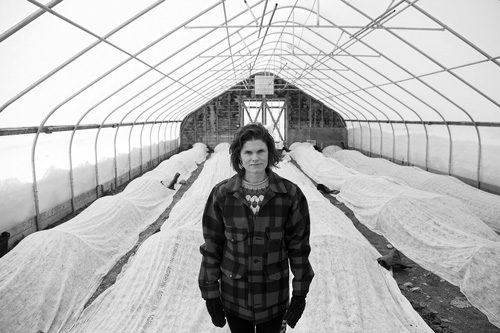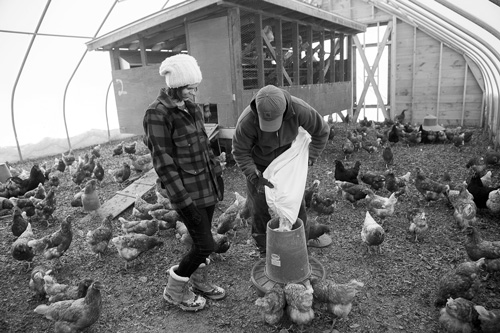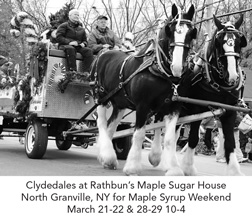News February-March 2015
A place at the table
Young farmers band together to keep land in agriculture
 By TRACY FRISCH
By TRACY FRISCH
Contributing writer
HUDSON, N.Y.
Lindsey Lusher Shute runs Hearty Roots Community Farm with her husband in Clermont, N.Y. Their struggle to find affordable farmland in the Hudson Valley prompted them to help organize the National Young Farmers Coalition, a grassroots advocacy organization based in Hudson. Scott Langley photo
Lindsey Lusher Shute and her husband were in their fifth year of growing organic vegetables in the Hudson Valley when they came face to face with a huge hurdle.
Like many young people starting out in agriculture, they had been working on rented property. To go forward and expand, they needed long-term control of agricultural land.
But finding a suitable property at an affordable price had become all but impossible in a region increasingly drawn into the outer orbit of metropolitan New York City. Even farmland that had been protected by conservation easements was being bought up – and often taken out of production – to create weekend preserves for affluent New Yorkers.
Lusher Shute and her husband, Ben, soon realized they weren’t the only young farmers facing this predicament.
Over the past decade, a new generation of idealistic young people has answered the call of the local and organic food movements by creating small-scale farms that satisfy the appetites of food-conscious consumers. This new back-to-the-land movement has been particularly strong in certain hotspots around the country, including the Hudson Valley, western Massachusetts and Vermont.
But unless they expect to inherit land from their families, young people like the Shutes are discovering that the cost of farmland can be the biggest obstacle to realizing their dreams.
The Shutes’ experience prompted them to help organize the National Young Farmers Coalition, a grassroots advocacy organization that is giving a voice to this new generation. The group is pushing for changes aimed at keeping farming viable – and open to newcomers -- amid the country estates of places like Columbia County and the Berkshires.
 The young farmers coalition, founded in 2011, now operates out of a second-floor office on Warren Street in Hudson. The group has grown to encompass two dozen chapters around the nation and an annual operating budget approaching $1 million, and it has started to become a force in shaping agricultural policy in Washington.
The young farmers coalition, founded in 2011, now operates out of a second-floor office on Warren Street in Hudson. The group has grown to encompass two dozen chapters around the nation and an annual operating budget approaching $1 million, and it has started to become a force in shaping agricultural policy in Washington.
Priced out of agriculture?
The Shutes’ story is typical among young people getting into farming. They started Hearty Roots Community Farm on rented land and began supplying organic vegetables to a base of member-shareholders under a business model known as community-supported agriculture.
Ben Shute had studied agriculture and apprenticed at a farm in Oregon. Though he had a fulfilling job with an anti-hunger advocacy organization in New York City, he still yearned to work the land.
Initially he joined a vegetable operation, started by a young woman in Dutchess County, as it entered its second year. This enterprise, started on a single acre on a former dairy farm, doubled its size in each succeeding year. Then the retired dairy farm couple that owned the land died, and the farm was put on the market with an asking price of $2.7 million.
By then the Shutes and another farming partner were renting 25 acres from a different farmer whom they described as an excellent landlord. But their lease didn’t allow them to put up any buildings, and they would soon need a structure for washing and packing produce to comply with proposed federal food safety requirements.
They also wanted to have land that they would control long term, because it can take years of effort to build the soil fertility needed for high-value crops like organic vegetables.
Despite their best efforts to find farmland in the Hudson Valley that they could call their own, they were running out of options.
“Every piece cost over a million dollars,” Lusher Shute recalled. “There was just nothing that was remotely affordable.”
As the Shutes searched for land to rent or buy, a friend was telling them about her own struggles renting farmland from a non-farmer.
The friend was Severine von Tscharner Fleming, the founder and driving force behind the Greenhorns. That organization, created in 2007, is dedicated to providing imaginative cultural supports for new farmers.
Based on these conversations, the three young farmers began envisioning an organization that would focus mainly on the economic challenges faced by young and beginning farmers.
“We decided that we needed to advocate for ourselves,” she explained.
A coalition takes root
As a first step, Lusher Shute, her husband and von Tscharner Fleming signed up to lead a workshop at a young farmers conference held annually at Stone Barns, a Rockefeller estate in Westchester County that’s been turned into an organic demonstration farm. (The conference has become so popular that admission is now by lottery.)
The response to their workshop seemed to confirm that the barrier of land access was national in scope, rather than specific to the Hudson Valley.
“The room was totally packed with young farmers from all over the country,” Lusher Shute recalled. “We ended up naming the coalition on the spot.”
Lusher Shute was given the task of organizing the new group. She had experience doing advocacy work at Transportation Alternatives, a nonprofit group in New York City.
The National Young Farmers Coalition went public in late 2011 with the release of its first report and policy recommendations. The report, “Building a Future with Farmers,” used the group’s national survey of more than 1,000 young farmers as the basis for identifying the two biggest challenges faced by beginning farmers: access to capital and land.
Today, the coalition boasts 24 chapters in about as many states. These regional groups help new farmers overcome the isolation that often goes with their chosen occupation. And through their affiliation with the coalition, young farmers are taken more seriously when they call their elected representatives.
The organization has grown to support eight full-time and five part-time employees. Besides its headquarters in Hudson, the group maintains regional offices in New York City and Durango, Colo. It also shares space in the nation’s capital with the National Sustainable Agriculture Coalition.
The group appears to be gaining influence and has already claimed some victories in shaping federal agriculture policy.
Its staff members, with portfolios like organizing and policy advocacy, travel extensively to present workshops, coordinate meetings and support local chapters. But its young farmer members themselves do much of the work of advancing their interests in the political arena.
“We rely on their engagement and activism to move an agenda forward,” said Lusher Shute, who became the organization’s executive director early on.
The coalition encourages its chapter leaders and members to reach out to elected officials and cultivate relationships with them. The group also strategically holds fly-ins to bring young farmers to Washington to meet with members of Congress.
So when Congress approved a five-year agricultural funding bill last year, the legislation contained several measures that the young farmers coalition had championed. The group, for example, was instrumental in pushing for expansion of a U.S. Department of Agriculture micro-loan program. The program now provides loans of up to $50,000 in operating capital to start-up farming enterprises – including livestock, small dairy and vegetable operations. So far the USDA has issued 8,000 of these loans.
Many of the young people drawn to the coalition’s mission are college-educated, first-generation farmers. Typically they didn’t grow up on a farm, and their families don’t have agricultural land to help them get started.
Aspiring farmers who don’t have a farm in their family have often been forced to put their agricultural ambitions on hold while they pursue other lines of work, sometimes for decades. Only when they accumulate enough capital have they been able to focus on farming. By then, they’ve sometimes reached their 40s or 50s.

One of the goals of the young farmers coalition is to change this situation.
“We don’t want it to be where you had to have a lucrative career first,” Lusher Shute said.
Instead, the group hopes to empower young people coming out of high school or college to build career paths directly into agriculture.
Lusher Shute said she also hopes to increase the diversity of the coalition’s members by, for example, pushing for more opportunities for farm workers, many of whom are immigrants, to develop their own farming enterprises.
“We should make sure the career path we’re creating is inclusive of people with other backgrounds,” she explained.
A need for new blood
Despite the strong interest in small-scale and organic farming in places like the Hudson Valley and Vermont, young farmers are actually in very short supply nationally. According to USDA statistics, only 6 percent of farmers nationally are under 35, and farmers over 65 outnumber those under 35 by a ratio of 6-to-1.
At the same time, family farming operations are less likely than in the past to be passed along from one generation to another. As older farmers retire or die in the years ahead, nearly a billion acres of U.S. farmland could be on the cusp of transition. Other farms will likely absorb some of this land, but much of it could also wind up being converted to other uses or simply left fallow.
Against this backdrop, U.S. Agriculture Secretary Tom Vilsack challenged Congress in 2010 to set a goal of bring 100,000 new farmers onto the land within five years.
The National Young Farmers Coalition has picked up on this challenge and is urging policy makers to think of farming as a kind of public service.
In one new initiative, the coalition is pressing for a route to student debt forgiveness for farmers. The coalition’s young members have pushed the group to take up this issue, even though it isn’t normally considered relevant to agriculture.
“When people are weighed down by existing debt, it’s much harder to leverage capital required to start a farm,” explained Eric Hansen, the group’s policy advocate in Washington.
Lusher Shute said debt relief from student loans would “enable and incentivize thousands of young farmers to farm.”
As a precedent, the group points to the federal Public Service Loan Forgiveness program, which provides debt relief from federal student loans to doctors, teachers, government employees and nonprofit workers who have made 10 years of income-based payments. The group would like to add farming to this list of occupations.
Hansen said the young farmer coalition’s student debt campaign bas been very positively received, and he anticipates legislation to provide debt relief to farmers will be introduced in Congress early this year.
Keeping land in agriculture
The coalition’s push for affordable farmland aims to go beyond protecting open space from development.
The group contends that in many cases, putting conservation easements on farmland has not proven sufficient to keep the land in working agriculture. Some farmland preserved through conservation easements winds up being folded into estates or converted into non-livelihood farms. And having such an easement doesn’t automatically make the land affordable to would-be farmers.
Jim Oldham, the director of Equity Trust, a national farmland protection group based in Massachusetts, said attitudes about the need for affordable farmland have changed significantly in just the past five years.
“While many factors are playing into it, the effective advocacy of the National Young Farmers Coalition is certainly one piece,” said Oldham, who has worked closely with the group. “Through their network, they’ve been able to call attention to these models. And when Ben and Lindsey write something in The New York Times, land trusts hear it.”
One tool that the coalition favors is the working-land easement, which ensures that when a conserved farm is sold, only another farmer can buy it -- and that its price will reflect the land’s agricultural value.
This type of easement provides another layer of protection on conserved land. In most states, it’s known as an “option to purchase at agricultural value.” In New York, where it’s not commonly used, it goes by the name “pre-emptive purchase right.”
Massachusetts has taken a different approach; it requires that when public funds are spent to put an agricultural easement on farmland, the land must continue to be actively farmed.
The Vermont Land Trust has been using working-land easements in all of its farmland conservation projects since 2004. Oldham said between 200 and 300 farm properties in Vermont now have working-farm easements as well as standard conservation easements, and he estimated that having both layers of protection reduces the price of farm properties by between 50 percent and 80 percent, making these protected farms more affordable to people new to farming.
Working-land easements are designed for areas where land prices are being driven up by development pressure or by the desire for large residential properties. (In contrast, the easements are ineffective in the Midwest, where competition among farmers is the main culprit behind rising land values.)
“We see it as a permanent way that land trusts can protect land for farmers,” said Holly Rippon-Butler, who joined the organization in May, immediately after completing her master’s degree at Yale, to manage its Land Access Campaign. Much of her work involves bridging the divide between young farmers and land conservancies.
Rippon-Butler grew up on her family’s small dairy and beef farm in Saratoga County, and she served as an intern at the Agricultural Stewardship Association, a conservation group based in Washington County.
When she took her new job at the young farmers coalition, she moved back to her family’s farm. Most mornings she milks cows, and she also drives a tractor and does field work with her parents. She said her experience of growing up on a family farm makes her especially committed to ensuring that small farms can survive locally and across the country for many years to come.
Supporting a smaller scale
The National Young Farmers Coalition aims to make it possible for young people to have farms that are big enough to support a family. But the group doesn’t favor agriculture of industrial scale or style.
Hansen laid out several reasons behind the group’s support for ecologically conscious farming at a family scale.
First, he said, consumers are demanding food that’s locally produced by farmers they know, using methods they feel comfortable with. Factory farms are fundamentally unable to satisfy that demand.
Second, as farms have consolidated into bigger and bigger production units, rural communities, especially in the farm belt of the Midwest, have been depopulated and as a result have ceased being places where many people want to live.
“We’re seeing farmers tell their kids to leave the farm and not return, because they don’t think there’s a future on the farm in rural America,” Hansen said. “We need a strategy to revitalize rural communities, and family-scale farms are an integral part of that.”
In addition, factors such as climate change and water scarcity, especially in the West, are driving unprecedented change in agriculture.
“We need smart people on the land who can innovate and adapt, rather than just do the same old thing,” Hansen said.
Finding a farm
At Hearty Roots Community Farm, it took the Shutes several more years of searching before they were able to find suitable land within their means. They eventually were able to buy a 70-acre parcel in the town of Clermont on which the environmental group Scenic Hudson had placed a traditional conservation easement.
The Shutes are now partnering with Equity Trust to add a working-land easement to the property. This project is being undertaken through Equity Trust’s five-year, grant-funded initiative to protect the affordability of farms throughout the Hudson Valley, from the New Jersey border to Washington County.
After 10 years, the Shutes’ community-supported farm serves 900 member-shareholders in the Hudson Valley and New York City. The Shutes are raising their two young children on the farm.
Besides their land, they own a barn, seven tractors and multiple hoop houses. Two full-time employees work on the farm year round, with up to 10 or 11 workers joining the crew at the height of the season.
And they’ve just built a new wash-and-pack station, with walk-in coolers, to comply with those pending food-safety standards.


